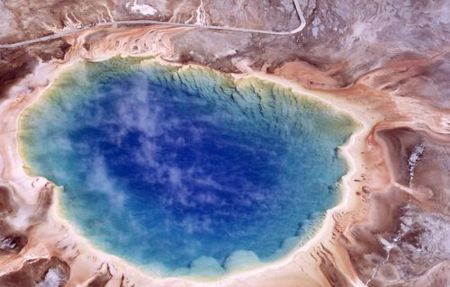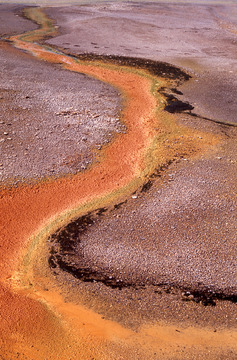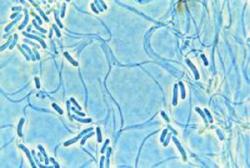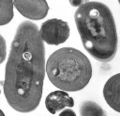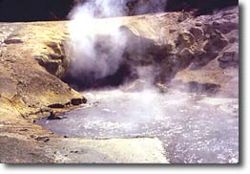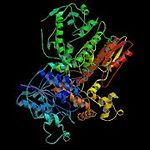Yellowstone Hot Springs
Introduction
Yellowstone National Park is one of the most interesting and unique places on Earth. Yellowstone is known for its geothermal activity that includes its famous geysers and hot springs that span across the entire park. Yellowstone is home to the third largest hot spring in the world, Grand Prismatic Spring, and hot springs here have been receiving more attention that ever for its unique colors and temperatures. Within these geothermal springs as well as in other countries, microbes have been identified to inhabit the elevated water temperatures and utilize the various resources available to them. Here we characterize the specific conditions and variability attributed to different regions in Yellowstone hot springs as well as address hot springs from other countries.
Yellowstone Hot Springs
What are hot springs?
Hot springs are geothermal springs that are substantially higher in temperature than the air temperature of the surrounding region.1 They are everywhere: different countries and areas, even some on the seafloor.2
Creation of Hot Springs
Hot springs can be created in different ways. They can either be created in a volcanic or non-volcanic manner. When created in an area near active volcanic zones, like Yellowstone, water becomes heated as it comes into contact with magma. This superheated water then rises back up, creating either a hot spring or geyser depending on the rate it rises. If it rises back up slowly, it will become a hot spring; if it rises back up quickly, it will become a geyser. When created in non-volcanic areas, water becomes heated as it comes into contact with hot rocks within the earth's crust. Then the water will rise back up to create hot springs.
The volcanic activity responsible for creating the hot springs are caused by the moving hot spot, which is currently under Yellowstone. About 17 million years ago, a meteorite collision occurred in present day southeast Oregon. The energy emitted from this collision resulted in heating of water near fault lines in Idaho. Because the impact in Oregon was so great, it remains stationary while the North American tectonic plate shifts above it. That's why, as the plate slowly moves, it creates a trace of volcanic activity as the hot spot erupts volcanic lava. As the plate above the hot spot continues to move, more craters will be created in Yellowstone. Believe it or not, Yellowstone was once a lush and forested environment.3
- Creation of Yellowstone Hot Springs
- Yellowstone hot springs are created in a volcanic manner through a "natural plumbing system." As cold water from snow or rain comes into contact with hot rocks from shallow magma chamber beneath the surface, temperatures rise above the boiling point to become superheated. It then remains in a liquid state due to the pressure and weight pushing down on it from the rock and water above it, creating convection currents that allow the more buoyant superheated water to slowly rise back toward the surface through rhyolitic lava flows. Some of the silica in the rhyolite are dissolved due to the high temperatures, forming a solution of silica within the water. Then as the water drops near the surface, immense pressure is exerted over them with the rise of the superheated water. If released in a slow and steady manner, the heat energy would give rise to a hot spring, which is the most abundant and colorful thermal feature in the park.4
Where is Yellowstone?
Yellowstone is a U.S. National Park located in Wyoming, Montana, and Idaho. Formed March 1, 1872, it is also America's first national park; and is a home to a large variety of wildlife including grizzly bears, wolves, bison, and elk. Preserved within Yellowstone National Park is the Old Faithful (one of the most predictable geysers), the Grand Canyon of Yellowstone, and a collection of the world's most extraordinary geysers and hot springs.5
Adjacent Communities
Yellowstone has many communities near its hot springs. There are over 1700 species of native plants and over 170 species of exotic (non-native) plants. Some of these unique native wildflowers include: the Wyoming Paintbrush, Sulfur Paintbrush, Dalmatian Toadflax, Butter and Eggs, Yellow Monkey-flower, Lewis’ Monkey-flower, Dwarf Purple Monkey-flower, Elephant’s Head, Blue the Small-flowered Penstemon, and Yellowstone’s own, the sand verbena. Yellowstone’s wildflowers are as diverse as its different vegetation zones. Lower elevations support marshlands and aquatic communities, whereas northern desert areas are home to grasses, sagebrush, and Rocky Mountain Juniper.6 Thermophilic communities form and grow in geothermal features of Yellowstone in a number of ways. Some species will form long, flexible structures called streamers in the fast-flowing water of runoff channels; others can form mats or layers of archaeal and bacterial communities that are adapted to specific temperature and light conditions within the mat.7
What Microbes Live in Yellowstone Hot Springs?
Thermophilic Microbes
The varieties of microbes found in Yellowstone National Park hot springs are thermophilic archaea and bacteria. Their classification “thermophile” translates literally to “heat loving”; these organisms can tolerate or even thrive in temperatures that many organisms are not well adapted to. The temperature range found at Yellowstone is approximately 30º to 100º C with a variable pH range and low concentration of organic matter.8
Due to the unique nature of their environment, these thermophiles have adapted a number of different features to help them survive in extreme conditions. Among the advantages that come with increased temperature are higher reaction rates, higher solubility of most chemicals, and increased fluidity and diffusion rates.9 Conversely, increased temperature could also result in protein denaturation and could prove detrimental to cellular processes. To compensate for the harmful effects of higher temperature, thermophilic microbes have unique features that allow them to thrive in their environment. They tend to have a higher melting temperature due to the high content of C and G nucleotides.10 Also, archaea that live in high-sulfur environments can gain energy by reducing sulfur anearobically. The majority of thermophillic archaea are actually anaerobes due to the low solubility of oxygen at high temperature. Other common features that allow archaea to live in extreme environments include cell wall components that include pseudomurein, special proteins and polysaccharides. Their membrane lipids consist of glycerol and isopranyl ethers as opposed to the acid esters of bacteria. Thermophilic bacteria can generally survive in maximum temperatures lower than thermophilic archaea. The survival mechanisms of bacterial thermophiles could involve modification of their cell wall (greater charged amino acids), lipids, and protein compositions.9 They also have modified cellular processes. For example, in the Thermus species, the electron transport chain, when compared to mesophiles, shows a lower molar growth yield for glucose, possibly explained by the higher membrane permeability of thermophiles.11
Temperature/Microbial Zones of Hot Springs
Pigmentation of thermophiles exposed to sunlight in the hot springs is a good indicator of the changes in temperature. We can divide the temperature ranges into four zones characterized by different microbes that are dominant in each zone.
- High Temperature Zone (>73ºC)
- The high temperature zone hosts heterotrophic and lithotrophic bacteria and archaea that are nonphotosynthetic.9 Although the high temperature zone do host a number of unique archaea and bacteria, the variety of microbes found in these zones is significantly less than zones with lower temperature because of its extreme environment.
- Synechococcus-Chloroflexus Zone (73-60ºC)
- Synechococcus-Chloroflexus zone is characterized by the presence of abundant amount of Synechococcus and Chloroflexus microbes that make up the yellow, orange, and greenish bacterial biofilms on water surfaces. Synechococcus are cyanophytes and are observed to make yellow and green biofilms on surfaces in contact with water temperature ranging from 67 to 73º C. The mats provide a natural system in which the organic matter such as photoexcreted glycolate formed by Synechococcus could be utilized by heterotroph organisms. Where Synechococcus makes yellow and green biofilms, the photosynthetic filamentous bacterium Chloroflexus auraniacus makes green and orange laminated mats on water surfaces ranging from 60 to 68º C. Thus, no bacterial mats in High temperature zones is observed where water is higher than 73 º C, but as the water cools down around these zones, an outline of yellow and green is present, and as temperature cools down further away, orange mats indicates the presence of Chloroflexus bacterium. Synechococcus and Chloroflexus also line the bottom of hot springs with water temperature lower than 73º C, where Chloroflexus can metabolize organic acids produced by the fermentation of organic matter.8,11
- Phormidium zone (60-30ºC)
- In the Phormidium zone, where water temperature ranges from 30 to 60ºC, the dominant species of filamentous cyanobacteria Phormidium forms extensive bacterial mats of varying morphologies with eukaryotic algae and fungi. These morphologies include:
- o Active streams: longitudinal bacterial streamers
- o Flat rubbery bacterial sheets: complex bacterial community, including Mastigocladus laminosus, which can tolerate freezing and dessication
- o Terrace pools: smalls subaqueous conical stromatolites and flat-topped stromatolites, both are varieties of Phormidium
- o Terrace fronts: thick rubbery mats
- In addition to these bacteria, Synechococcus and Chloroflexus are also present in this zone.11
- Calothrix zone (<30ºC)
- The Calothrix zone, with water temperature lower than 30ºC, is characterized by grayish-brown flat and postular mats of filamentous cyanobacteria Calothrix. This zone tends to be shallow (less than five cm deep) and has closely packed vertical and subvertical bacterial filaments that are, like Phormidium, coated with silica. These filaments form small microspicular branching shrublike masses that are denser and more resistant to crushing than the bacterial mats formed by Phormidium.11
Yellowstone Hot Spring Regions
Lower Geyser Basin
Lower Geyser Basin is the largest geyser basin of Yellowstone National Park, locating between Old Faithful area and Madison Junction. After the Yellowstone Caldera erupted about 600,000 years ago and the floor of the giant crater dropped downward along a ring-shaped fault, molten rock, hot water, and steam move through conduits at various levels beneath the caldera to shape up what is now the Lower Geyser Basin 12. Within the 12-square-mile geyser lays a variety of thermal features such as mud pots, geysers, pools, fumaroles and the most- studied hot springs, Octopus Spring and Mushroom Spring.
- Mushroom Springs
- Mushroom Spring is silicious and moderately alkaline with pH around 8 and has a temperature range of 60ºC’s. The spring contains very low sulfate concentration with reduced activity of sulfur cycle with depths due to both sulfate and carbon limitation. However, its microbial mat sustains a highly active sulfur cycle by sulfate-respiring prokaryotes (SRP) 13.The highly active population of SRP mediates both oxidizing and reducing pathways of the sulfur cycle even with low concentration of sulfate. There is also a measurable amount of glycolate which governs the relationship of many glycolate-excreting bacteria and glycolate-incorporating bacteria such as Synechococcus lividus and filamentous heterotrophs. This relationship shows that many bacteria in Mushroom Spring as well as in other Yellowstone hot springs operate closely in communities.
- Synechococcus lividus and filamentous heterotrophs share a cross-feeding relationship. The photosynthesis by S. lividus promotes glycolate photoexcretion while filamentous heterotrophs incorporate the excreted glycolate 14. Glycolate is a major photoexcretion product whose production is light-dependent and increased in the presence of O2. However, the oxidation of glycolate to CO2 is not completely light-dependent, suggesting that there is a working relationship between both photoheterotrophic and chemoheterotrophic organisms to metabolize glycosylate. These two types of bacteria work in adjacent to each other to synthesize and utilize glycolate.
- Sulfate-respiring Prokaryotes (SRP) are obligate anaerobes that can reduce sulfate with the highest rates after the depletion of oxygen chemocline at dusk or in immediate response to shading. The reoxidation of sulfide occurs via either aerobic oxidation or anoxic photosynthesis, but is inhibited when both oxygenic and anoxygenic photosynthesis is reduced by shading 13. Sulfate respiration is an important process in thermophilic microbial mats despite fluctuation of oxygen levels and very low sulfate concentration of the spring.
- Octopus Springs
- Octopus Spring is warmed by the heat generating from the magma below the surface. The hot water dissolves the silica of volcanic rock and precipitates it, giving the silicate deposits, or sinter, a grayish white color 15. The spring has a temperature range of 95ºC near the source to 60ºC. There is also a lack of hydrogen sulfide in the water, making it alkaline with a pH around 8. The spring has a high concentration of hydrogen gas due to the bacteria that utilize it. There is a diverse collection of bacteria thriving in the hot spring mats including photoautotrophic, photoheterotrophic, chemoautotrophic, and heterotrophic organisms 16.
- Synechococcus is a thermophilic cyannobacterium which has the highest temperature tolerance of the cyanobacteria in this ecosystem, up to 71ºC. The bacteria have evolved to temporally separate photosynthesis and N2 fixation to maximize the use of organic sources in Octopus Spring. There are critical regulatory switches that control many metabolic processes within the bacteria as well as in other organisms in the microbial mat. The bacteria have nif genes that are expressed when the mat becomes anoxic under declining photon irradiance in the late afternoon. The gene is correspondingly related to the increase in nitrogenase activity which fixes N2 during the night 16. Fixing N2 requires a lot of energy; therefore, the bacteria rely on fermentation process to acquire energy to power N2 fixation at night time 17. Overall, Synechococcus rely on photosynthesis and respiration during the day when O2 level is high, but switch to fermentation and N2 fixation at night.
- Methanobacterium thermoautotrophicus is a strictly anaerobic, autotrophic extremophile that is irregularly shaped as curved rods which often formed long filaments 18. M. thermoautotrophicus have an optimum temperature for growth and methanogenesis of 65ºC to 70ºC. The bacteria use ammonia as nitrogen source, sulfide as sulfur source and hydrogen- carbon dioxide as main energy and carbon source. Their ability to use hydrogen for reducing power and carbon dioxide classifies them as hydrogen-oxidizing autotroph. The ability of the bacteria’ ribosomes to undergo a 20% increase in hyperchromicity and endure high heat plays an important role in governing the maximal growth temperature of the bacteria depending on the areas 18. Overall, M. thermoautotrophicus seem to optimally adapt to the temperatures at which they are found 19.
- Thermocrinis rubber is a Gram negative bacterium which has a rod shape and is motile by rotating its monopolar polytrichous flagella. T. rubber cells grow predominantly as long filaments on solid surfaces. The bacteria can survive in temperature range between 44ºC to 89ºC with the optimum temperature of 80ºC. With a high content of GC ratio of around 47%, the bacteria can highly adapt to high temperature environment. The bacteria, like many others, can utilize a variety source of nutrients such as molecular hydrogen, thiosulfate, elemental sulfur, formate and formamide as electron donors; oxygen as electron acceptor; and CO2, formate and formamide as carbon sources 20. The ability of the bacteria to take advantage of many resources as food and energy allow them to survive in extreme environment of Octopus Spring.
Norris Geyser Basin
Norris Geyser Basin (Norris Basin) is located north from the Yellowstone caldera and between the Hebgen Lake and Mammoth Springs. This location in Yellowstone can be broken down into three main areas called the Porcelain Basin, Back Basin, and One Hundred Springs Plain. Norris Basin is better known for the geysers it is home to, which includes Steamboat Geyser, the largest and highest shooting active geyser in the world, and Echinus Geyser. To many scientists, researchers, and tourists that visit Yellowstone National Park, Norris Geyser Basin is considered one of the most interesting and diverse regions. This is attributed to the fact that the Basin contains a variety of hot spots and thermal activity in the form of hot springs, geysers, and mud volcanoes, and is also one of the few regions in Yellowstone that undergoes drastic changes in thermal activity and landscape. One of the noteworthy changes observed is when a hot spring transforms into a geyser or a geyser changes into a hot spring.21
Besides the abundance of geysers, Norris Basin also consists of hot springs that are inhabited by various microbes. The groups of hot springs that exist in this region are mostly acidic (between pH 2 and 3) with the temperature of each individual hot spring varying across the region. Most hot springs in this regions are considered acid-sulfate-chloride (ACS) springs due to the high acid and sulfate content. The microbes that inhabit acidic environments (including the hot springs here) and have a mode of survival in low pH are collectively called acidophiles. Some of the hot springs that are home to these microbes which have been characterized include Green Dragon Springs and Beowulf Springs. The best characterized microbe known to be abundant in Norris Basin is the thermophile Sulfolobus known for oxidizing hydrogen sulfide to sulfuric acid at high temperature and acidic pH.7 Recent studies on acid-sulfate-chloride geothermal springs have shown that chemical gradients of energy resources (i.e. Hydrogen Gas) create a distinct community dependent on the distance from the geothermal discharge source of the spring with distinct resources being more concentrated or less concentrated going away from the source such as arsenite oxidation being inhibited in the high-sulfide zone of the spring.22,23,24
- Green Dragon Springs
- This hot spring is located in the One Hundred Springs Plain of Norris Geyser Basin. Dragon Springs has been well characterized as a near boiling acid-sulfate-chloride spring due to its high chemical composition of sulfate and chloride. The spring’s pH is about 3 with the temperature ranging from 66°C to 73°C. Other components of the hot spring include various organic carbon sources, hydrogen sulfide (H2S), Iron (II), As (III), and an abundance of elemental sulfur. Due to the temperature, pH, and available energy sources, microbes living in Dragon Springs (as well as other hot springs with similar conditions) have acquired the ability to utilize available elements or ions for energy. Some of the microbes recently identified include two Crenarchaeas (phylum within the domain Archaea), chemo-organotrophes that uses elemental sulfur for energy, and an new class of chemolithotrophic microbes that oxidize As(III) to As(V) for energy.25,26
- Beowulf Springs
- This spring is located not too far from Green Dragon Springs in the One Hundred Springs Plain of Norris Geyser Basin, YNP. The specific conditions for Beowulf Springs is also similar to Green Dragon Springs and consists of a temperature near 70°C and pH of 3.2. Beowulf Springs is also considered an acid-sulfate-chloride geothermal spring like many other springs in Norris Geyser Basin. While Green Dragon Springs is best characterized for its elemental sulfur, the Fe(III) oxide (Hydrous Ferric Oxide) microbial mats that exist in this spring are best characterized here. The Fe(III) oxide mats have been observed to have thermophilic Crenarchaea, which have the capability of oxidizing iron. Besides iron metabolism, like many other hot springs in Norris Basin, other sources like sulfate may be used as an energy source.27
Hot Springs of Other Countries
Chile
One country known for having hot springs is Chile. The water found in the hot springs originates from volcanoes found throughout the country. Most of the hot springs are surrounded by lush vegetation and can be found near an inlet of water. A majority of the hot spring’s temperature ranges from 125˚F to 185˚F (52˚C to 85˚C). Some hot springs such as the Puyuhuapi have a pH of 6.3 while others such as Huife have a slightly more basic pH of 8.8. The hot springs are rich in minerals such as magnesium, chlorides, bromides, calcium, sodium, zinc, sulfur, etc. These hot springs have therapeutic benefits as well since in some hot springs the water can be ingested as tonic water or can be used to relieve rheumatism, arthritis, bronchitis, fatigue and skin conditions.28
Iceland
Situated on the fault between the North American and European plates, Iceland is volcanically and geologically active with numerous geothermal features, such as hot springs, mud pots, geysers, and fumaroles. Geothermal hot springs in Iceland are divided into high temperature fields and low temperature fields. High temperature areas, which are only found on the active volcanic rift zones, have temperatures of at least 150°C with a heat source of magma chamber. The low temperature fields, found in the vicinity of Reykjavik, have temperatures of less than 150°C at a depth of one kilometer.29 These varying features provide habitats for different groups of thermophilic life. Some famous hot springs in Iceland include the one in Grindavik, and Europe’s highest flow rate hot spring Deildartunguhver, which has a flow rate of 180 liters/second emerging at 97°C. Some of the water is used for heating as energy sources.30,31
Bacteria belonging to the genus Thermus are the most abundant microbes found in Icelandic hot springs. These bacteria are thermophilic, aerobic heterotrophs. The temperature range for these bacteria was found to be 55 to 85°C, and the pH range was from about 6.5 to above 10. The optimum temperature for the growth of Thermus spp. is found to be 75°C 32. They are able to utilize a variety of organic substrate for growth and may be the most important hetertrophs in the hot spring ecosystem.
Japan
A volcanically active island country, Japan has approximately 150 hot springs (onsen) with 14000 individual springs. The hot springs are broken down by different temperature ranges: less than 25°C, 25-34°C, 34-42°C, and higher than 42°C, and are called rai sen, bi on sen, on sen, and kou on sen, respectively. pH value of hot springs differ from place to place. The natural acidic hot springs have pH values of less than 5. For most of the onsen, pH ranges from 5 to 8.33 In contrast with Yellowstone hot springs, Japanese hot springs are mainly places to relax and are considered to have various medical effects. Different minerals or chemicals in onsen’s water have different therapeutic uses. For example, the carbonate springs, which haves less than 1 gram of radical carbon and other mineral elements in each liter, are good for heart disease, blood circulation disorders, neurological disorders, and female disorders. Simple springs, which have water temperature higher than 25°C, are thought to be good for neuralgia, rheumatism and long term rehabilitations.34 Some of the popular springs in Japan are Kusatsu Onsen, Hakone, Kamuiwakka Falls, and Beppu.
Microbes in natural hot springs are mainly thermoacidophilic. An archaebacterium, Thermoplasma acidophilum, was found in hot springs in Hakone. Its cells are irregular in shape due to the lack of cell walls and their cytoplasmic membrane consists mainly of tetraether lipid. Also, this organism can grow anaerobically in the presence of sulfur. Based on the features, it was proposed that Thermoplasma sp. is a host cell of the endosymbiosis theory of eukaryotic cells 35
New Zealand
New Zealand is very popular for having many hot springs throughout the country. In the 19th century, there were about 220 erupting hot springs, but now there are approximately 58, most of which have been turned into spas and resorts. The water found in the hot springs comes from 3 geological features: younger erupting volcanoes, older cooler volcanoes and water near fault lines. The temperature at the center of the volcano of the hot springs can be even greater than 300˚C, but most have been cooled to approximately 30˚ to 45˚C to be used in spas. The hot springs are rich in minerals such sodium, calcium, sulfur, potassium, magnesium, and chlorides. These hot springs are often used for therapeutic effects, such as relieving arthritis pains, bronchial infections and for cleaning the skin.36,37,38
There are some microbes and microbe products that were found in some of the New Zealand hot springs. A thermophilic anaerobic spirochete was found to grow in optimum temperature of 45˚C to 50˚c and pH of 7.0-7.5. Also oncoids, which are coated grains that are produced by microbes such as cyanobacteria were found in the hot springs of New Zealand. 39,40
Unique Facts
One of the microbes that was discovered by bacteriologist Thomas Brock in the 1960’s was Thermus aquaticus. This microbe was a major discovery because it could not only survive in temperatures near 100˚C and was one of the first microbes that can be considered an archaea, but also provided an enzyme that was essential for the PCR reaction. TAQ polymerase, which is the enzyme produced by the Thermus aquaticus is a thermostable DNA polymerase. It is also used for 3”A-tailing of blunt ends, primer extensions and DNA sequencing. PCR is a technique that allows researchers to produce millions of copies of specific DNA sequences and amplify DNA is a short amount of time.41,42,43
One article in the New York Times stated that populations of microbes found in different regions are distinct. The further apart the hot springs are from each other, the more genetically different the microbes are.44 The archaebacterium found in Japan differ greatly from the microbe found in New Zealand and the bacteria found in one of the hot springs in Yellowstone. While the one in Japan lacks a cell wall and has an irregular shape, the spirochete found in New Zealand have a distinct spiral shape and the Thermus rubber from Yellowstone is rod shaped and uses a flagella for movement. Also the microbe from Iceland is an aerobic bacteria while some of the microbes from Yellowstone, Japan and New Zealand are anaerobic. These microbes further confirm the notion that microbes are not genetically similar throughout the world.
Closing Thoughts
- Yellowstone National Park is composed of many different and unique geographical features which contain microbes that have adapted to the extreme conditions. The hot springs contain thermophiles that have managed to thrive in extreme temperatures that other organisms could not survive and have specialized metabolism. There are not an abundance of microbes that are found in the hot springs because of the extreme heat. There are also other hot springs found throughout the world that contain microbes that are unique to conditions of the individual hot springs. It is truly amazing that these thermophiles can survive in the hot springs found in Yellowstone and throughout the world.
Current Research
(1) Mycobacterium parascrofulaceum in Acidic Hot Springs in Yellowstone National Park (2007)
- Environmental mycobacteria have a high resistance to chlorine and biocides in water and are able to form biofilm. Their tolerance to extreme temperatures and starvation survival allow them to persist in extreme environments. This research was performed in two unnamed thermal springs and their runoffs in the One Hundred Springs Plain. This system of two springs is very acidic (pH 3.0), with temperatures ranging from 45.8°C to 40.0°C. A total of 18 water samples were collected in several locations along the temperature gradients of the hot springs. Some samples were extracted with InstraGene matrix and tested by PCR targeting of part of the 16S-23S spacer region, PCR primers sp1 and sp2. The remaining samples were concentrated by filtration through nylon membrane and cultured at different temperatures. Positive cultures were then confirmed by auramine-rhodamine fluorescence microscopy and PCR. DNA sequences of the bacteria were compared with current database sequences to determine phylogenic relatedness. Positive results indicated that Mycobacteria spp. have a high adaptability to temperature. M. Parascrofulaceum isolates were again incubated at 42°C and 55°C for 60 days and analyzed by auramine-rhodamine fluorescence microscopy to confirm their temperature resistance. The experiment performed the first isolation of mycobacteria and confirmed that M. parascrofulaceum could grow at this temperature. 45
(2) High Rates of Sulfate Reduction in a Low-Sulfate Hot Spring Microbial Mat are Driven by a Low Level of Diversity of Sulfate-Respiring Microorganisms (2007)
- The role of sulfate respiration in the microbial mat found in the low-sulfate thermal outflow of Mushroom Spring, one of the low-sulfate thermal spring effluent environments, was evaluated using radiometric rate measurements, chemical profiling, and phylogenetic analysis. Cyanobacterial microbial mats are self-sustaining communities that support all major biochemical cycles. This mat community is able to sustain an active sulfur cycle despite of the low sulfate concentrations. In this study, samples were collected from Mushroom Spring for further nucleic extraction, sulfate determinations and sulfate reduction rates (SRRs). By using capillary electrophoresis and ion chromatography to determine the hot spring conditions, it is shown that the pH levels and temperature were fairly stable since 2000 and that sulfate levels in the Mushroom Spring microbial mat were very low. The highest rates of sulfate respiration occur during the day close to the surface of the mat when photosynthetic oxygen production stopped. This increase in sulfate reduction rates at the Mushroom Spring mat surface may be related to the decrease of oxygen that inhibited sulfate respiration or reoxidizing sulfide. From PCR amplification, cloning and sequencing, it reveals that only a single dsrAB phenotype in the upper two millimetric layers. Surface sequences were 99% identical at the amino acid level and are most closely related to the Thermodesulfovibrio clade. This study helped the understanding of the geobiochemistry of the early Earth, in which oxidized sulfur species were less abundant that today.46
(3) Virus movement maintains local virus population diversity
- There were several studies that analyzed the populations of individual viruses in their natural environment. The Sulfolobus spindle- shaped viruses (SSVs) and Sulfolobus islandicus rod shaped viruses (SIRVs), which are genus specific and restricted to certain geographical regions, found in the hot springs in Yellowstone were monitored for two years. The purpose of this research was to determine if the level of viruses changed over time and if they remained consistent with other research studies of viral diversity at a local level.
- Each hot spring that was monitored maintained a hot temperature and acidic conditions for two years. Each hot spring also had its own unique collection of archaea. The viral genes from the samples were amplified by PCR amplification and were sequenced. Evidence showed that the viruses immigrated to different hot springs rather than mutating. This is an important observation because it gives a picture of how other viral metacommunities moved and their roles in ecology and evolution.47
(4) Thermophilic Amoebae and Legionella in Hot Springs in Yellowstone and Grand Teton National Parks
- The algal mat biofilm community in Nymph Creek, Yellowstone National Park showed that there were thermophilic free-living Valkampfiid amoebae present. There was previous research that showed that some Valkampfiid such as Naegleria fowleria that were pathogenic and fatal to humans. These amoebae are excellent hosts for bacterial cells such as Legionella pneumophila.
- In this research, a rapid method of sampling and analyzing the communities using primers that targeted the Naegleria species was developed. Traditional culture based methods in addition to PCR amplification with primers that targeted the 16SrRNA genes of Naegleria were used. Samples of approximately 5mL of sediment, algal mat and biofilms were obtained from 5 locations near Nymph Creek were collected. These samples were taken from locations that had a temperature range from 3-51˚C and were immediately frozen and taken to the lab to be examined.
- A total of twenty three different sites that differed in temperature and pH were sampled. Five Legionella species were found, four of which were previously known and one new species. There was evidence that Legionella survived best in Valkampfiid rich cultures, providing primary evidence that amoebae are good hosts for pathogenic bacteria such as Legionella 48
References
1 "hot spring." Encyclopædia Britannica. 2008. Encyclopædia Britannica Online. 26 Aug. 2008.
4 Yellowstone Hot Springs. 2008. Yellowstone National Park Hot Springs. 27 Aug. 2008.
6 Stoddard, Jane. Yellowstone's Wildflowers. 26 Jun. 2008. The Sun. 26 Aug. 2008.
7 Yellowstone National Park. 24 Jun. 2008. Microbial Life Educational Resources. 27 Aug. 2008.
8 Riding, Robert E. and Stanley M. Awramik. Microbial Sediments. Berlin, Germany: Springer-Verlag Berlin Heidelberg, 2000.
9 Kristjansson, Jakob K. Thermophilic Bacteria. Boca Raton, Florida: CRC Press, 1992.
10 Sharp, Richard, and Ralph Williams. Thermus Species. New York, New York: Plenum Press, 1995.
11 Reysenbach, Mary Voytek, Mary Voytek, and Rocco Mancinelli. Thermophiles: Biodiversity, Ecology, and Evolution. New York, New York: Kluwer Academic/Plenum Press, 2001.
12 Yellowstone Geysers: Lower Geyser Basin.
17 Grossman, Arthur. Hot-Spring Bacteria Flip a Metabolic Switch. Eurekalert. 2006 January.
19 Sandbeck, Kenneth A.; Ward, David M.. AEM. 1982 October; 4(4): 844-851.
29 Geothermal Resources in Iceland. 1995.
32 Spring. Encyclopædia Britannica. 2008. Encyclopædia Britannica Online. 28 Aug. 2008.
33 Japanese Onsen Spa Guide. Japan Travel. 2008.
34 Hot Spring in Japan. East Creative Inc., 2004.
41 'Forecast: Hot and Humid.' University of Wisconsin, Board of Regents, 1999.
42 TAQ Polymerase. Genscript Corporation, 2007.
43 Polymerase Chain Reaction. Gene Almanac.
Edited by [Yu-Chen Chiu, Ngoc Dinh, Jenny Lee, Christina Pham, Lucas Puttock, Naon Shin], students of Rachel Larsen
